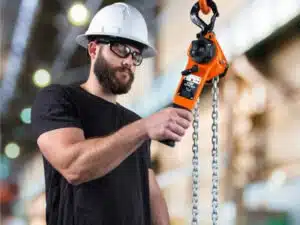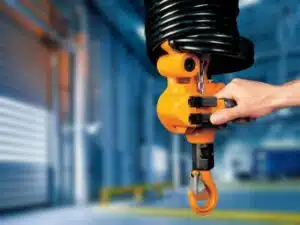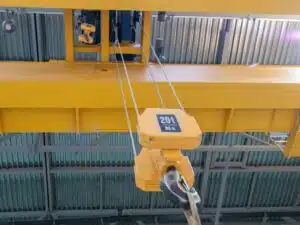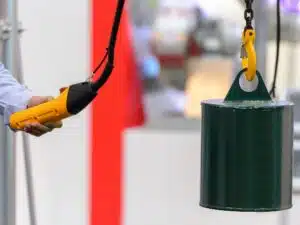Hoists
Choose The Right Hoist: The Ultimate Buyer’s Guide
In order to choose the best hoist, you must first understand your lifting needs. Then it's a matter of choosing the right type of hoist as well as the features such as capacity, lift height, lift speed, suspension, trolley type (if applicable), and more.

Initial Thoughts
Unless you’re a seasoned veteran, choosing the right hoist to buy can be a daunting task. But have no fear. This guide will make things absolutely clear about which hoist is right for your specific need. Without further ado, let’s walk step-by-step through the Ultimate Hoist Buyer’s Guide.
What Is A Hoist?
A hoist is a machine specifically designed to raise and lower loads that are too heavy for manpower alone. Hoists have a drum or wheel around which wraps either a chain or rope which controls whether the load is raised or lowered. Most hoists are electric-powered, but they can also be pneumatic (air-powered) or manually operated. To learn more, check out our article explaining what hoists are, as well as some examples and tips when operating them.
What Are Hoists Used For?
Generally speaking, hoists are used for lifting and lowering heavy loads. However, hoists are used in many different industries for various applications. To be more specific, hoists are used for construction purposes, in the automotive industry, and even in the aerospace industry. In fact, we compiled a list of 15 use cases for hoists in various industries.
What Are The Different Types of Hoists?
The first step to determining which hoist you should buy is in researching which general type of hoist will best suit your needs. After that is determined, we can nail down the specifics. So what are the different types of hoists?
Manual Chain Hoists

Manual chain hoists are not ideal for every scenario. However, there are plenty of situations where a manual hoist is the best solution. Let’s review some advantages and disadvantages of using manual hoists over a powered hoist.
Advantages of Manual Chain Hoists:
- Extremely Portable
- Low Maintenance
- Flexible Options
- Low Cost
- Great In Hazardous Areas
- Doesn’t Require Electricity or Air
Disadvantages of Manual Chain Hoists:
- Low Lift Height
- Requires Some Manpower
- Often a Temporary Solution
The Best Manual Chain Hoists
In our experience, CM hand chain hoists are some of the best in the industry and they offer a large selection of products. However, we also put together a list of the top 3 best manual chain hoists if you’d like to do some more research. With that said, these are our favorite hand chain hoists in the CM line and they all come with a lifetime warranty.
Electric Chain Hoists
Electric chain hoists are powered by electricity and utilize chains as opposed to wire rope to lift their load. Instead of having to manually crank a lever, the operator of an electric chain hoist need only push a button to raise or lower the cargo.
Just as manual chain hoists are not ideal for every scenario, electric chain hoists have their pros and cons. Ultimately, the choice to purchase this type of hoist will depend on your intended use case. Let’s look at those pros and cons.
Advantages of Electric Chain Hoists:
- Electricity is widely-used and inexpensive
- Productivity, ergonomics, and safety are enhanced
- They are often highly portable
- Many configurations avaible
- Provides true vertical lift
Disadvantages of Electric Chain Hoists:
- Requires electrical access
- Typically more expensive than manual hoists
- Not ideal for dangerous environments
- Requires more maintenance than manual hoists
The Best Electric Chain Hoists
According to our experts, the best electric chain hoists are manufactured by Budgit, CM, Coffing, and Harrington. However, we also put together a list of the top 5 best electric chain hoists if you’d like to do some more research. With that said, these are some of our favorite electric chain hoists from the aforementioned brands.
Air Chain Hoists

Air-powered hoists are the perfect choice for certain situations but not for others. Let’s take a look at some of the advantages and disadvantages of air hoists.
Advantages of Air Chain Hoists:
- Self-cooling
- Explosion-proof
- Operable outdoors
- Operable in harsh or dangerous environments
- Higher speeds of operation
- Easier to repair
Disadvantages of Air Chain Hoists:
- More expensive to operate
- More maintenance than electric hoists
- Required air compressor
The Best Air Chain Hoists
There are several hoist manufacturers that produce air chain hoists. However, we have found Budgit air-powered hoists to be some of the best in the industry. With that said, feel free to review our list of the top 3 best air chain hoists if you’d like more information. Yet, these are certainly among the best pneumatic hoists out there.
Wire Rope Hoists

Chain hoists are more common than wire rope hoists. However, wire rope hoists also have the greatest utility within particular industries. Depending on the circumstances, these will be the best type of hoist for the job at hand.
Advantages of Wire Rope Hoists:
- Rated for heavier loads
- Ideal for extended work time
- Fast lifting speeds
Disadvantages of Wire Rope Hoists:
- Not easily moved once mounted
- More expensive than chain hoists
The Best Wire Rope Hoists
Out of all wire rope manufacturers, we’ve found Yale to be among the most reliable brands. They’ve been a leader in the hoist manufacturing business for over a century. We have a few Yale wire rope hoists featured below or feel free to browse all wire rope hoists by clicking the button below.
Choosing The Right Hoist For You
Now we know of the different types of hoists available: electric chain hoists, air chain hoists, manual chain hoists, and wire rope hoists. Now it’s time to determine what capacity, lift height, and other factors you should consider when choosing a hoist.
If you have further questions after this section, I highly recommend you check out our FAQ section or reach out via our contact page.
What Capacity Do I Need?
To determine what capacity you will need for your hoist, it’s important to first determine the weight of the maximum load that will be lifted.
For example, if you will be lifting loads with a maximum weight of 1.5 tons, you will need a hoist with a capacity of at least 1.5 tons. Otherwise, your device will fail and you will risk injury or worse. However, it’s common practice to choose a capacity with at least 1/4 or 1/2 ton more than the weight of your heaviest load.
What Lift Height Do I Need?
Another important factor when choosing the right equipment is the lift height, otherwise referred to simply as ‘lift’. To determine the lift needed, measure the distance between the load and the point at which the hoist will be mounted, then subtract the hoist headroom (the distance between the load-bearing hook and the point where the hoist will connect to the beam/trolley).
What Power Source Does My Hoist Require?
Electric Hoists
There are a few factors to consider for choosing a power source for your wire rope or electric chain hoist. First, you will have to determine if the voltage you have access to. Common voltages for powered hoists are 115V, 230V, 460V, and 575V. Next, you will need to know the phase of your power supply, either single-phase or three-phase. Typically larger and industrial workplaces will run three-phase power and have voltages over 230V. Lastly, you’ll need to determine hertz, the unit of measurement frequency, or the change in state or cycle in alternating current, of one cycle per second.
Pneumatic Hoists (Air Hoists)
Air hoists, also known as pneumatic hoists, have a connected up-and-down control pendant similar to regular hoist systems. However, they also come with the added floating functionality provided by the compressed air that powers them. The beauty of the floating air function is that it allows for weightless vertical movement.
Manual Hoists
Hand chain hoists are operated by a loop of lifting chains to raise and lower their load. These are often an ideal match for construction, automotive, and hobbyist applications.
Lever hoists, also known as ratchet hoists or a come-along, allow the operator to pull, lift, and position materials in horizontal or vertical directions through a lever or crank mechanism. These provide easy rigging and operation with 360° rotation of the lever and top swivel hook.
What Other Factors Should I Consider?
Lift speed
Lift speed refers to the speed at which the hoist can raise/lower objects. The necessary lift speed will vary greatly between hoists and their various uses. Some may be single-speed or multi-speed. When determining the appropriate lift speed, there are a few factors to consider: the type of load being lifted, the weight of the load, the surrounding environment, and the space around the load.
Pendant control cable length
Pendant control cable length refers to the length of the cable of the pendant control. The standard push button drop is equal to 4 feet less than the lift. Special lengths for pendant cable drop can be configured to meet specific needs as well.
Suspension
Suspension refers to the mounting type of the hoist. There are two options for hanging a chain hoist, Hook mount or Lug mount. A Hook mounted hoist will come from the factory with a hook attached to the top of the body. There are two common types of hooks available, rigid and swivel. The rigid hook is in a fixed position, whereas the “swivel” hook-mounted hoist can rotate up to 360 degrees.
Trolley
A trolley refers to the beam on which the hoist is mounted. There are 3 common types of trolleys; plain trolley, geared trolley, and motorized trolley. A plain/push is operated by maneuvering the trolley along the beam by human power via the hoist operator. A geared trolley is used by pulling a chain hanging from the trolley to maneuver the hoist along the beam or track. The motorized trolley option has a motor attached to the side of the trolley wheels and usually has its own control pendant.
I-Beam flange width
I-Beam flange width refers to the width of the flanges at the top and bottom of the beam. The horizontal elements of the “I” are flanges, while the vertical element is the web. The web resists shear forces while the flanges resist most of the bending moment experienced by the beam. Beam theory shows that the I-shaped section is a very efficient form for carrying both bending and shears loads in the plane of the web.
Final Thoughts
In order to choose the right hoist, there are a number of factors that must be considered. For instance, hoist type, capacity, lift height, lift speed, voltage, and more. Once you have identifies the attributes needed for your hoist, feel free to browse our shop or request a quote if you need something beyond what we have listed. We’re determined to help you find the right lifting equipment!

